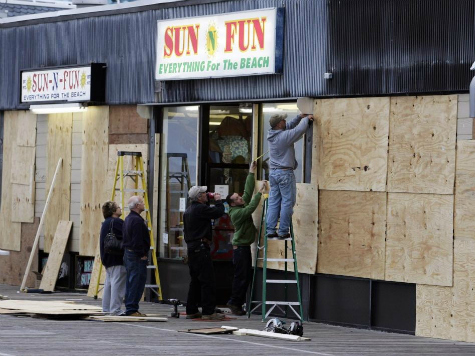UNION CITY, New Jersey — Two towns devastated by Hurricane Sandy may lose hundreds of thousands of dollars in aid after a federal audit found insufficient evidence to prove their debris removal expenses. Officials tell the Bergen Record that “inaccurate or incomplete guidance from the many FEMA Project Specialists” was to blame.
Many have attacked Governor Chris Christie for insufficiently providing recovery resources to those affected by Hurricane Sandy. However, some of the towns hardest hit are accusing the federal government’s recovery program of forcing the small towns’ administrators into navigating an unwieldy bureaucracy that may now force them to return financial aid, though reconstruction is still incomplete.
The towns, Little Egg Harbor and Beach Haven, are both Ocean County towns on the Jersey Shore. Little Egg Harbor faces Beach Haven over the Barnegat Bay, which separates Beach Haven and the rest of Long Beach Island from mainland New Jersey. Both towns suffered significant damage in the aftermath of the storm. Nonetheless, Beach Haven is being called upon to return $344,000 in “unsupported claims,” and Little Egg Harbor is expected to return $689,000 if it cannot find appropriate documentation.
The administrators of both towns said they provided FEMA with all the required documentation requested, except some alternative documentation provided by contractors. Little Egg Harbor’s administrators say that FEMA sent too many people to their office, and it appears none of the federal officials properly communicated with one another.
“We did what the people at FEMA who were sent to us told us to do, and then the auditors came and told us something else,” Mike Fromosky, assistant business administrator for Little Egg Harbor, told the Record. The newspaper noted that Little Egg Harbor did not work with the county on debris removal. Instead, it did the work on its own with FEMA backing. Beach Haven Manager Richard Crane told the paper that FEMA initially “gave us carte blanche to do this, that, the next thing. We were taking it on faith.” He said he was shocked that the town was now expected to pay on its own.
FEMA spokesman Alberto Pillot responded by saying, “It is hard to believe that any person from FEMA ever advised them that they have carte blanche.”
A spokesman for Governor Christie told the Star-Ledger that he believed the audits resulted merely from the size of the grants given both towns: “Generally speaking those claiming debris removal expenses above $1 million are candidates for potential audit–for no other reason necessarily than crossing that threshold.”
The distribution of Hurricane Sandy aid funds has been a controversial topic for the Christie administration since CNN reported that a federal audit of Christie’s office had begun for use of funds to pay for the “Stronger than the Storm” tourism campaign, which took place during Christie’s own campaign for reelection. The audits on Ocean County towns are particularly controversial given the lack of similar investigations of towns that received aid despite not being especially affected by the storm.
Almost one third of all funds distributed after Hurricane Sandy went to unaffected areas in New Jersey. Of the projects funded in these towns, among the most egregious was a residential complex, already in the construction planning stages before the hurricane, in New Brunswick, an inland town in Middlesex County and best known as the home of Rutgers University. That complex cost the state $4.8 million.
The difficulty individuals have had filing for relief from the state and FEMA has also raised much suspicion about the competence of those running the relief program. A study found that blacks and Latinos impacted by the storm were far more likely to have their aid grant applications rejected than white applicants. Last November, the one-year anniversary of the storm brought with it reports that many victims could not pull together funds to make a Thanksgiving meal, relying on private charity for the occasion. And while Middlesex County received aid despite being inland, areas like southwestern Cumberland County received little attention.

COMMENTS
Please let us know if you're having issues with commenting.